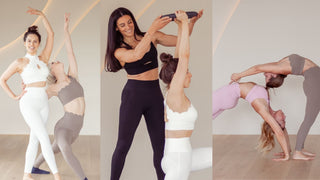Introduction
Are you gearing up for your next Pilates session but unsure about what to wear? Pilates is a form of exercise that emphasizes controlled movements, flexibility, and core strength, making it essential to wear the right attire to get the most out of your session. The key to perfect Pilates attire lies in finding the balance between comfort, flexibility, and style.
In this article, we’ll dive into 7 expert tips on what to wear for your Pilates class, answer frequently asked questions, and offer practical advice to help you stay focused on your practice without any wardrobe distractions. Whether you’re a beginner or a seasoned Pilates enthusiast, these tips will ensure you feel confident and comfortable on the mat.
1. Form-Fitting Clothes: Movement Without Distraction
Wearing form-fitting clothing is crucial for Pilates. Loose, baggy outfits can hinder your movements and make it difficult for instructors to correct your form. Opt for clothing that stays snug to your body, allowing you to move freely while ensuring your alignment is visible for better guidance.

FAQ: Why are form-fitting clothes recommended for Pilates?
Tight-fitting clothes allow your instructor to see your body’s posture and alignment clearly. This visibility ensures proper form during exercises, reducing the risk of injury.
Power Tip: Try leggings with a high waistband for extra support during your workout and to keep everything in place, especially when performing core-focused exercises.
2. Breathable, Moisture-Wicking Fabrics: Stay Cool and Dry
Pilates may not involve intense sweating like cardio workouts, but that doesn’t mean moisture-wicking fabrics aren’t important. Look for breathable, moisture-wicking materials like polyester blends, bamboo, or merino wool. These fabrics will keep you cool, dry, and comfortable throughout your session.

Statistic: According to a fitness apparel study, 80% of Pilates practitioners prefer moisture-wicking fabrics over cotton for better temperature regulation and sweat control during workouts.
Key Insight: Opting for fabrics that breathe well and wick moisture away from your skin will help maintain comfort and prevent distractions during your session.
3. Layer Up for Warmth (But Keep It Light)
Your body temperature will fluctuate during Pilates. Start your session with layers, such as a light jacket or long-sleeve top, which you can easily shed as your body warms up. Avoid bulky clothing that may get in the way of your stretches or reformer machine.

FAQ: Is layering necessary for Pilates?
Layering can be beneficial, especially during the warm-up phase, as it helps maintain body heat. Just be sure to wear pieces that are easy to remove when your muscles heat up.
Power Tip: A zip-up hoodie or fitted long-sleeve top is ideal for Pilates warm-ups because they can be quickly taken off once you feel warm.
4. Supportive, Stretchable Sports Bras for Women
For women, wearing a supportive sports bra is key for comfort and mobility. While Pilates is a low-impact workout, you still need a bra that provides adequate support without restricting your movement. Look for sports bras with stretchable fabrics and medium support that can accommodate various exercises.

Key Insight: Seamless sports bras are a great option as they reduce irritation and chafing during mat-based exercises or reformer sessions.
5. Non-Slip Pilates Socks: Enhance Your Grip
Some Pilates studios require participants to wear non-slip socks, especially for reformer Pilates, where foot positioning is crucial. These socks have grippy soles that prevent slipping and provide stability, helping you maintain proper alignment during your exercises.

FAQ: Are non-slip socks necessary for Pilates?
While not all studios require them, non-slip socks can improve your grip and stability, especially on slippery surfaces or reformer machines.
Power Tip: Invest in high-quality Pilates socks with silicone grips that cover the entire sole for maximum traction.
6. Avoid Zippers, Buttons, and Bulky Details
Minimalism is key when selecting your Pilates attire. Avoid clothes with zippers, buttons, or bulky seams that can cause discomfort when lying down on the mat or using the reformer machine. Clothes with too many details can get caught in equipment or dig into your skin during certain movements.

Key Tip: Opt for seamless leggings or tops with smooth finishes to minimize distractions and maximize comfort during your practice.
7. Choose Comfort Over Trends
While it’s tempting to follow the latest fashion trends in activewear, always prioritize comfort and functionality over aesthetics. Your Pilates attire should be supportive and allow for full range of motion. That said, you don’t have to sacrifice style—plenty of stylish yet functional Pilates clothing options are available that blend both comfort and fashion.

FAQ: Can I still look stylish during Pilates?
Absolutely! You can choose sleek, fitted outfits in neutral tones or opt for fun patterns. Just ensure the fabric and fit align with the demands of your Pilates practice.
Conclusion
Choosing the right outfit for your Pilates session is about combining comfort, support, and style. By wearing form-fitting, breathable clothing, non-slip socks, and supportive undergarments, you’ll ensure a distraction-free session that allows you to fully focus on your movements and technique.
Remember to keep it simple and functional, avoiding any bulky or restrictive clothing that might hinder your performance. Whether you’re layering up for warmth or slipping into a pair of moisture-wicking leggings, these tips will help you achieve the perfect Pilates ensemble. Now that you know what to wear for your next Pilates session, it’s time to hit the mat and flow through your movements with ease and confidence.
